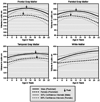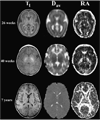Neuroimaging studies of normal brain development and their relevance for understanding childhood neuropsychiatric disorders
- PMID: 18833009
- PMCID: PMC2759682
- DOI: 10.1097/CHI.0b013e318185e703
Neuroimaging studies of normal brain development and their relevance for understanding childhood neuropsychiatric disorders
Abstract
Objective: To review the maturational events that occur during prenatal and postnatal brain development and to present neuroimaging findings from studies of healthy individuals that identify the trajectories of normal brain development.
Method: Histological and postmortem findings of early brain development are presented, followed by a discussion of anatomical, diffusion tensor, proton spectroscopy, and functional imaging findings from studies of healthy individuals, with special emphasis on longitudinal data.
Results: Early brain development occurs through a sequence of major events, beginning with the formation of the neural tube and ending with myelination. Brain development at a macroscopic level typically proceeds first in sensorimotor areas, spreading subsequently and progressively into dorsal and parietal, superior temporal, and dorsolateral prefrontal cortices throughout later childhood and adolescence. These patterns of anatomical development parallel increasing activity in frontal cortices that subserves the development of higher-order cognitive functions during late childhood and adolescence. Disturbances in these developmental patterns seem to be involved centrally in the pathogenesis of various childhood psychiatric disorders including childhood-onset schizophrenia, attention-deficit/hyperactivity disorder, developmental dyslexia, Tourette's syndrome, and bipolar disorder.
Conclusions: Advances in imaging techniques have enhanced our understanding of normal developmental trajectories in the brain, which may improve insight into the abnormal patterns of development in various childhood psychiatric disorders.
Figures









References
-
- Huttenlocher PR, Dabholkar AS. Regional differences in synaptogenesis in human cerebral cortex. J Comp Neurol. 1997;387(2):167–178. - PubMed
-
- Levitt P. Structural and functional maturation of the developing primate brain. J Pediatr. 2003;l43(suppl 4):S35–S45. - PubMed
-
- Black IB, DiCicco-Bloom E, Dreyfus CF. Nerve growth factor and the issue of mitosis in the nervous system. Curr Top Dev Biol. 1990;24:161–192. - PubMed
-
- Giedd J. Brain development, IX: human brain growth. Am J Psychiatry. 1999;156(1):4. - PubMed
-
- Molliver ME, Kostovic I, van der Loos H. The development of synapses in cerebral cortex of the human fetus. Brain Res. 1973;50(2):403–407. - PubMed
Publication types
MeSH terms
Grants and funding
LinkOut - more resources
Full Text Sources
Other Literature Sources
Medical

